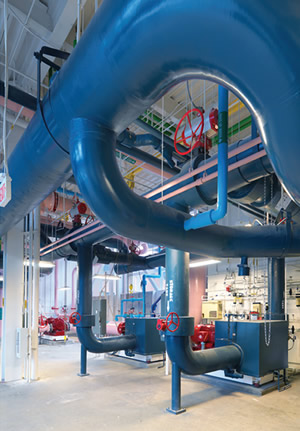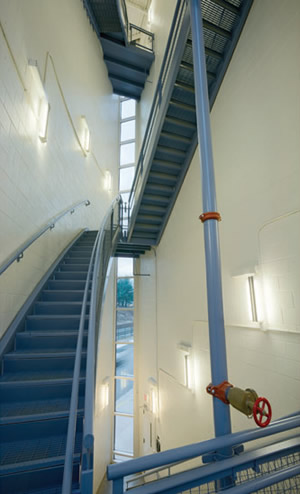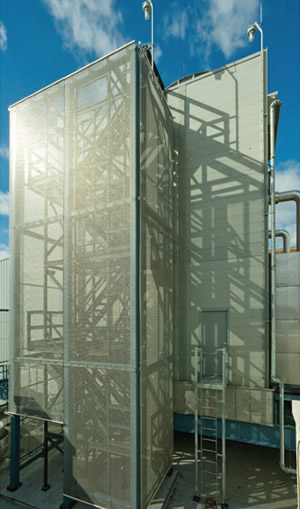Water World

PHOTOS COURTESY OF AYERS SAINT GROSS
With California’s drought reaching dangerous levels, everyone seems to have water on their minds. But while most people only think about the stuff that comes out of taps or showerheads, college facility managers know there’s more to water than drinking and bathing. Non-potable water is an important part of HVAC systems, and mismanaging it can cause expensive damage, equipment failures and illness. Yet managing that water is something that is often left to unqualified staff or chopped in a round of budget cuts.
The results can be costly and downright dangerous.
POTENTIAL LOSSES
“The water that runs through HVAC systems naturally grows bacteria,” explains Christopher Roeder, regional manager, Southern Region, Barclay Water Management, Inc. Left untreated that bacteria, along with corrosion and mineral scaling, can cause a variety of issues from inefficiencies to equipment failure to actual human illness.
Inefficiency costs real money. “A one percent loss of efficiency in your school’s boiler translates to $40,000 to $50,000 a year in added fuel costs while the chiller is the biggest electrical draw on campus,” according to Roeder. “Both work at their peak if there is no scaling or bacteria in the system.”
If an inefficient system gives facility managers pause, then total equipment failure should send chills down their spines. “Think about the distribution system, the ‘veins and arteries’ that run through your school,” says Roeder. Many of these pipes are buried underground or deep within a building’s walls. Roeder says a single corroded pipe could mean total failure. “It’s never just in a single spot. One failure usually means there’s 100 more right behind it.”
Pete van der Have, instructor in facility management, College of Applied Science and Technology, Weber State University, and regular columnist for this magazine, has had experience with equipment failure and the results were traumatic. “I had a chiller go out at a high-end research facility,” he says. “A scientist lost $3 million to $4 million in research.”

PHOTOS COURTESY OF AYERS SAINT GROSS
A HOME FOR BACTERIA
These results to the bottom line are upsetting, but inconsequential when compared to actual human illness. A type of bacteria called Legionella causes Legionnaires’ disease, a form of atypical pneumonia. The Legionella bacteria are found naturally in the environment, usually in water. The bacteria grow best in warm water, like the kind found in cooling towers, according to the Centers for Disease Control and Prevention (CDC) website.
“The reason this is all so important to HVAC professionals is that two of the most common places to find Legionella are cooling towers and large central air-conditioning systems. The bacterium thrives in stagnant warm water (hence its prevalence in cooling towers) and causes disease when people inhale contaminated mist or vapor. This means you could hardly think of a better method of spreading Legionnaires’ disease and Pontiac Fever [a nonfatal flu-like illness] than central air-conditioning,” according to the Goodway Blog (www.goodway.com/hvacblog. Goodway Technologies Corporation is a manufacturer of cleaning systems.)
These reasons stack the deck in favor of consistent water treatment. Yet in times of financial stress these operations are often cut and the results can be disastrous. “It’s like brushing your teeth,” explains Roeder. “Small maintenance keeps things healthy, but if you consistently skip brushing you could end up with an expensive root canal.”
FINDING A BALANCE
Schools have several choices when it comes to keeping their HVAC water healthy and in balance. They can do it themselves or contract with a service. “We used to tackle this on our own,” remembers van der Have, likening his method to the “hammer, duct tape and baling wire method. We would buy and apply the chemicals ourselves, but we didn’t get the results we wanted.”
Van der Have notes that today larger institutions are more likely than smaller ones to do their own treatment. He explains significant pitfalls to that approach. “I found a case where the head custodian was in charge of the task. That is not a job that the head custodian is trained for.”
Even though larger institutions are more likely to do their own water treatment, most usually don’t. “If I had to guess I would say about 80 percent of large schools either contract it out or do some hybrid approach,” says van der Have. “The smaller you are the more likely you are to look for outside help.”

PHOTOS COURTESY OF AYERS SAINT GROSS
That outside help comes in two sizes: large companies (like Barclay Water Management) and small local firms. “It’s a cutthroat business,” says van der Have, who has found that larger companies usually handle the testing and documentation a bit more expertly. “Everyone has access to the chemicals,” he says. “I’ve had good luck with a regional firm in my career.”
“We provide communication,” explains Roeder. “We can identify small issues before they become big problems.” Roeder states that along with on-site testing he can also monitor a system remotely.
THE GREEN LIE
Water treatment is done with chemicals: chlorine, bromine, isothiazolinone, molybdate and phosphonate. Schools looking to move away from chemicals to a “greener” solution may be tempted by the non-chemical treatment devices (NCDs) that some companies offer. These include magnetic, electrostatic, ultrasonic and hydrodynamic treatments. They should proceed with caution.
“Magnets are snake oil. They attract more fisherman than fish,” says van der Have. “I’m not aware of any protocol that works as well as the correct chemical treatment.”
A 2010 technical report by Radisav Vidic, professor of Environmental Engineering at the University of Pittsburgh, substantiates van der Have’s experiences. That study found “that NCDs did not control biological growth under the conditions of the testing in the pilot scale cooling tower systems.”
For those that are still squeamish when it comes to chemicals, Roeder states that the chemicals still need to meet EPA guidelines. “These chemicals are measured in parts per million,” he says. “I would argue the chemicals make the system greener by keeping it in peak performance.”
This article originally appeared in the issue of .